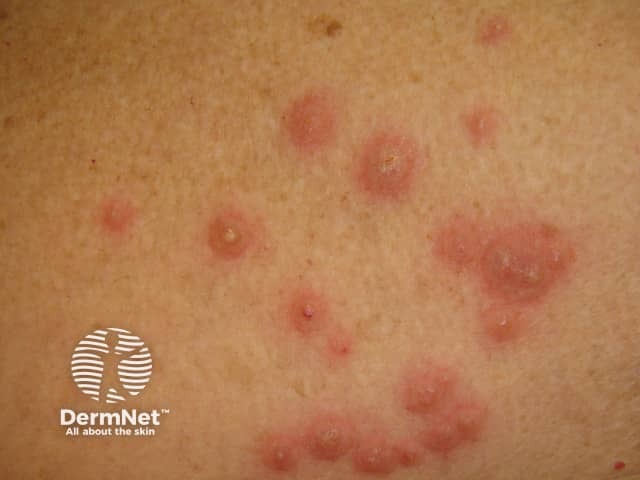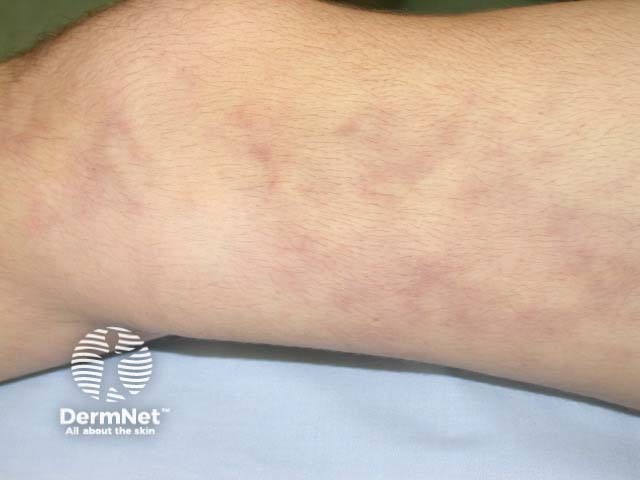Main menu
Common skin conditions

NEWS
Join DermNet PRO
Read more
Quick links
VEXAS syndrome — extra information
VEXAS syndrome
Authors: William Hao Syuen Ng, Medical Student, University of Newcastle, Newcastle, Australia; Dr Martin Keefe, Dermatologist, Christchurch, New Zealand. Copy edited by Gus Mitchell. September 2021
Introduction
Demographics
Causes
Clinical features
Complications
Diagnosis
Differential diagnoses
Treatment
Outcome
What is VEXAS syndrome?
VEXAS (Vacuoles, E1 enzyme, X-linked, Autoinflammatory, Somatic) syndrome is an adult-onset severe inflammatory and/or haematological disorder due to a somatic mutation in the UBA1 gene on the X chromosome, first described in 2020.
Who gets VEXAS syndrome?
Although initially thought to be rare, since the first description of VEXAS syndrome in October 2020 it is being increasingly diagnosed on retrospective genetic testing of patient cohorts identified by clinical features including series from France, the Netherlands, and the USA, as well as individual case reports.
VEXAS syndrome is almost exclusively described in males, with most cases diagnosed in mid to late adult life. At least 70 cases have now been reported in recent months with an age range of 45–80 years and a median age at symptom-onset in the late 50s to mid 60s.
There has been one female with VEXAS syndrome reported who had a single X-chromosome.
What causes VEXAS syndrome?
VEXAS syndrome is due to an acquired somatic (mosaic or postzygotic) mutation affecting the methionine-41 codon (p.Met41) in UBA1. This gene encodes the major E1 enzyme involved in the activation of ubiquitin, a small regulatory protein which attaches to substrate proteins (ubiquitylation). The p.Met41 mutation results in decreased ubiquitylation particularly in haematopoeitic stem cells with subsequent activation of the innate immune system.
What are the clinical features of VEXAS syndrome?
VEXAS syndrome is clinically heterogeneous but is characterised by autoinflammatory, treatment-resistant manifestations most commonly involving the skin and bone marrow.
Cutaneous features
- Polychondritis — involving the nose and/or ear; sparing the airways and ribs
- Neutrophilic dermatoses — resembling acute febrile neutrophilic dermatosis (sweet syndrome); tender, red-violaceous, firm, pigmented or purpuric papules, nodules, and plaques which can be umbilicated
- Vasculitis — resembling livedo racemosa, polyarteritis nodosa, or giant cell arteritis

Relapsing polychondritis

Sweet syndrome

Livedo reticularis in polyarteritis nodosa
Haematological features
- Macrocytic anaemia (mean corpuscular volume > 100fl), with normal folate and vitamin B12 levels
- Thrombocytopenia (platelet count < 200 x103/microlitre)
- Myelodysplastic syndrome, multiple myeloma, monoclonal gammopathy of undetermined significance (MGUS)
Other clinical features
- Systemic symptoms including fatigue and recurrent fevers
- Inflammatory arthritis
- Neutrophilic alveolar infiltrate
What are the complications of VEXAS syndrome?
- Respiratory failure
- Progressive anaemia
- Multiorgan involvement including kidney, heart, brain, and bowel
- Thrombotic events including venous thromboembolism and arterial stroke
How is VEXAS syndrome diagnosed?
VEXAS syndrome should be considered in the male patient with complex overlapping inflammatory and haematological features, although all components may not be present at initial presentation.
Investigations may include:
- Blood tests
- Raised inflammatory markers
- Macrocytic anaemia, thrombocytopenia, lymphopenia
- Bone marrow biopsy — hypercellular with vacuolisation of erythroid and myeloid precursors is a characteristic but non-specific finding
- Skin biopsy of infiltrated skin lesions — perivascular mature neutrophils with leukocytoclasis, CD163+ myeloid cells with indented nuclei, and lymphoid cells.
- DNA sequencing — whole exome or targeted Sanger sequencing identifying the UBA1 gene mutation in myeloid cells on skin biopsy, peripheral blood, or bone marrow samples.
What is the differential diagnosis for VEXAS syndrome?
VEXAS syndrome presenting with dermatological manifestations may be initially diagnosed as having the specific dermatosis.
What is the treatment for VEXAS syndrome?
VEXAS syndrome typically responds poorly to treatment, with high dose systemic corticosteroids (> 20mg/d) showing the most consistent benefit for the inflammatory features. Other DMARDs and immunosuppressive drugs are ineffective. Colchicine may reduce the steroid requirement. Tocilizumab is a theoretical option being trialled.
Treatment for myelodysplastic syndrome, multiple myeloma, or MGUS have been mostly unsuccessful with a partial response at best. Autologous stem cell transplantation in one patient induced only a short-lived remission of 6 months before symptoms recurred.
What is the outcome for VEXAS syndrome?
VEXAS syndrome is a chronic progressive autoinflammatory syndrome. Patients have often had symptoms for 4-5 years before the diagnosis is made. However, the long-term prognosis appears poor: the mortality rate in a Netherlands study was 50% and in a series from the USA, 9/16 died from disease-related causes.
Bibliography
- Barba T, Jamilloux Y, Durel CA, et al. VEXAS syndrome in a woman. Rheumatology (Oxford). 2021;keab392. doi:10.1093/rheumatology/keab392 PubMed
- Beck DB, Ferrada MA, Sikora KA, et al. Somatic mutations in UBA1 and severe adult-onset autoinflammatory disease. N Engl J Med. 2020;383(27):2628-38. doi:10.1056/NEJMoa2026834. Journal
- Ferrada MA, Sikora KA, Luo Y, et al. Somatic mutations in UBA1 define a distinct subset of relapsing polychondritis patients with VEXAS. Arthritis Rheumatol. 2021;10.1002/art.41743. doi:10.1002/art.41743. PubMed
- Himmelmann A, Brücker R. The VEXAS syndrome: uncontrolled inflammation and macrocytic anaemia in a 77-year-old male patient. Eur J Case Rep Intern Med. 2021;8(4):002484. doi:10.12890/2021_002484. Journal
- Huang H, Zhang W, Cai W, et al. VEXAS syndrome in myelodysplastic syndrome with autoimmune disorder. Exp Hematol Oncol. 2021;10(1):23. doi:10.1186/s40164-021-00217-2. Journal
- Kirino Y, Takase-Minegishi K, Tsuchida N, et al. Tocilizumab in VEXAS relapsing polychondritis: a single-center pilot study in Japan. Ann Rheum Dis. 2021;annrheumdis-2021-220876. doi:10.1136/annrheumdis-2021-220876. PubMed
- Koster MJ, Kourelis T, Reichard KK, et al. Clinical heterogeneity of the VEXAS syndrome: a case series. Mayo Clin Proc. 2021;S0025-6196(21)00481-X. doi:10.1016/j.mayocp.2021.06.006. PubMed
- Obiorah IE, Patel BA, Groarke EM, et al. Benign and malignant hematologic manifestations in patients with VEXAS syndrome due to somatic mutations in UBA1. Blood Adv. 2021;5(16):3203–15. doi:10.1182/bloodadvances.2021004976. PubMed Central
- van der Made CI, Potjewijd J, Hoogstins A, et al. Adult-onset autoinflammation caused by somatic mutations in UBA1: a Dutch case series of patients with VEXAS. J Allergy Clin Immunol. 2021;S0091-6749(21)00819-8. doi:10.1016/j.jaci.2021.05.014. PubMed
- Zakine E, Schell B, Battistella M, et al. UBA1 Variations in neutrophilic dermatosis skin lesions of patients with VEXAS syndrome. JAMA Dermatol. 2021;10.1001/jamadermatol.2021.3344. doi:10.1001/jamadermatol.2021.3344. PubMed
On DermNet
- Autoinflammatory syndromes
- Inflammasomes and inflammatory skin diseases
- Skin manifestations of haematological diseases
